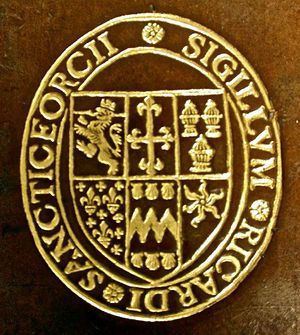Difference between revisions of "Richard St George 1554/5-1635"
| (10 intermediate revisions by 4 users not shown) | |||
| Line 1: | Line 1: | ||
__NOTITLE__ | __NOTITLE__ | ||
===[[personal title::Sir]] [[name::Richard]] [[name::ST GEORGE]] [[date of birth::1554;1555|1554/5]]-[[date of death::1635]]=== | ===[[personal title::Sir]] [[name::Richard]] [[name::ST GEORGE]] [[date of birth::1554;1555|1554/5]]-[[date of death::1635]]=== | ||
| − | + | [[file:RichardStGeorge.jpg|thumb|The armorial stamp of Richard St George (British Armorial Bindings)]] | |
====Biographical Note==== | ====Biographical Note==== | ||
| − | Born at [[place of birth::Hatley St George, Cambridgeshire]], son of [[family::Francis St George]], a member of a long established gentry family there. Matriculated at [[education::St John's College, Cambridge]] 1575, but did not graduate. Became a member of the [[organisations::Society of Antiquaries]] founded ca.1586, and subsequently entered the [[organisations::College of Arms]], where he became [[occupation::Berwick Pursuivant]] in 1602, and [[occupation::Norroy King of Arms]] in 1607. He carried out numerous visitations and in 1623 was promoted to [[occupation::Clarenceux King of Arms]], on the death of [[ | + | Born at [[place of birth::Hatley St George, Cambridgeshire]], son of [[family::Francis St George]], a member of a long established gentry family there. Matriculated at [[education::St John's College, Cambridge]] 1575, but did not graduate. Became a member of the [[organisations::Society of Antiquaries]] founded ca.1586, and subsequently entered the [[organisations::College of Arms]], where he became [[occupation::Berwick Pursuivant]] in 1602, and [[occupation::Norroy King of Arms]] in 1607. He carried out numerous visitations and in 1623 was promoted to [[occupation::Clarenceux King of Arms]], on the death of [[crossreference::William Camden 1551-1623|William Camden]]. He was knighted in 1617. |
====Books==== | ====Books==== | ||
| − | Books, rolls of arms and manuscript collections were always part of the stock in trade of heralds, and numerous [[format::manuscript|manuscripts]] either owned or written by him are now in the [[present repository::British Library]], and the [[present repository::College of Arms]]. [[format::Printed]] books from his library also survive in various places. He had regular contact with many of the other antiquaries of early 17th century [[location::London]], including [[ | + | Books, rolls of arms and manuscript collections were always part of the stock in trade of heralds, and numerous [[format::manuscript|manuscripts]] either owned or written by him are now in the [[present repository::British Library]], and the [[present repository::College of Arms]]. [[format::Printed]] books from his library also survive in various places. He had regular contact with many of the other antiquaries of early 17th century [[location::London]], including [[crossreference::Robert Cotton 1571-1631|Cotton]] and [[crossreference::William Camden 1551-1623|Camden]], and [[associates::John Weever]], the compiler of Ancient funeral monuments, referred to St George's help. In his will, he [[bequest::bequeathed]] all his books and evidences in his study in [[location::Holborn]], together with all the books, household stuff and other furniture in his chamber at the [[organisations::College of Arms]], to his [[beneficiary::son]] [[family::Sir Henry St George]] (1581-1644); he also made a specific [[bequest::bequest]] of the large Church Bible in his [[location::Holborn]] study to the church of [[beneficiary::Hatley St George]]. |
====Characteristic Markings==== | ====Characteristic Markings==== | ||
| Line 23: | Line 23: | ||
[[Category:Heralds]] | [[Category:Heralds]] | ||
[[Category:Libraries Bequeathed to Towns, Parishes, etc]] | [[Category:Libraries Bequeathed to Towns, Parishes, etc]] | ||
| − | |||
[[Category:Mottoes]] | [[Category:Mottoes]] | ||
| + | [[Category:All Owners]] | ||
Latest revision as of 03:56, 12 July 2022
Sir Richard ST GEORGE 1554/5-1635
Biographical Note
Born at Hatley St George, Cambridgeshire, son of Francis St George, a member of a long established gentry family there. Matriculated at St John's College, Cambridge 1575, but did not graduate. Became a member of the Society of Antiquaries founded ca.1586, and subsequently entered the College of Arms, where he became Berwick Pursuivant in 1602, and Norroy King of Arms in 1607. He carried out numerous visitations and in 1623 was promoted to Clarenceux King of Arms, on the death of William Camden. He was knighted in 1617.
Books
Books, rolls of arms and manuscript collections were always part of the stock in trade of heralds, and numerous manuscripts either owned or written by him are now in the British Library, and the College of Arms. Printed books from his library also survive in various places. He had regular contact with many of the other antiquaries of early 17th century London, including Cotton and Camden, and John Weever, the compiler of Ancient funeral monuments, referred to St George's help. In his will, he bequeathed all his books and evidences in his study in Holborn, together with all the books, household stuff and other furniture in his chamber at the College of Arms, to his son Sir Henry St George (1581-1644); he also made a specific bequest of the large Church Bible in his Holborn study to the church of Hatley St George.
Characteristic Markings
St George had an armorial stamp which is commonly found gilt-stamped on his books. He typically inscribed his books with "Liber Ricardi St George Norroy" or similar, sometimes adding the date; Cambridge UL M*.1.18-21 has a hand-drawn shield, and in the second volume the motto "Fero et spero". Examples: Cambridge UL M*.1.18-21, R*.8.8(B); Bodleian MS Willis 52; Maggs catalogue 1121 (1990)/7; Bloomsbury Book Auctions 16.3.2006/108.
Sources
- British Armorial Bindings.
- Godfrey, W. The College of Arms, 1963, 86-7.
- Woodcock, Thomas. "St George, Sir Richard (1554/5–1635), herald." Oxford Dictionary of National Biography.
